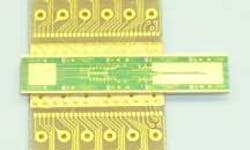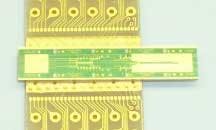Companies place their faith in optical packet switching
With packet-based Ethernet and IP traffic expected to remain common currency in carrier networks, the impetus to find optical means to switch packets-either individually or in bursts-has grown stronger. A pair of Japanese companies, Nozomi Photonics and Yokogawa Electric, used the exhibit floor at September’s European Conference on Optical Communication (ECOC) in Glasgow, Scotland, to show optical switching technology they say can meet packet-switching requirements.
Nozomi (San Jose and Tokyo), founded in 2002, has developed a novel way to produce PLZT-an acronym for (Pb,La)(Zr,Ti)O3-waveguides that form the heart of a dc switch operating at switching speeds of <10 nsec. The technology also provides a combination of dense integration, device miniaturization, and low power dissipation that competing technologies such as lithium niobate and silicon-based planar lightwave circuits (PLCs) can’t match, says company president Keiichi Nashimoto.
Nozomi has demonstrated typical coupling loss of 1.5 dB using mode conversion fiber, although Nashimoto believes that can be reduced to under 1 dB in the future. According to a paper the company presented at a recent IEEE workshop on optical switching, typical insertion loss for packaged 1x8 switches is <10 dB; once optimized, such loss should fall to 5 dB. The switch’s driver electronics were designed for 10-V applications with <10-nsec rise and fall time, controlled by 3.3-V input signals. The company displayed a similar switch module based on PLZT at ECOC. Nashimoto says both NTT and KDD are doing R&D on packet and burst switching using Nozomi devices.He also says Fujitsu has worked with PLZT. The trick is fabricating such waveguides. Nozomi uses solid-phase epitaxy to create the waveguides on Nb-doped semiconductive SrTi O3 substrates. This process enables low-voltage current properties through the creation of an electrode-waveguide-electrode/substrate “sandwich” with a narrow electrode gap geometry. Light coupled in the waveguides is switched when voltage is supplied between the top electrodes and the substrates, lowering the refractive index of the waveguide between them. Nashimoto hopes to use the process to create other devices, including monolithically integrated subsystems.
Of course, having a fast optical switch is only one technical hurdle to optical packet switching. Optical buffering also will be necessary, and while research continues in this area, it appears that buffering lags switching in terms of development. For this reason, Nashimoto and sales and marketing director Jerome Prieur say burst switching may reach deployment before packet switching. They report that Japanese government organizations have burst switching on their near-term roadmaps for 2007, with vendors offering equipment to the market the following year.
Meanwhile, Yokogawa Electric (Tokyo) demonstrated in its ECOC booth a 40-Gbit/sec packet switching network based on its own equipment. A prototype PLC-based switch that leverages total reflection by current injection formed the engine for the small network, with a 6×6 version of the switch used in conjunction with a delay fiber to provide packet buffering.
In its simplest 1×2 configuration, the PLC portion of the switch features a pair of crossed waveguides. An electrode resides at the crosspoint; when current is injected, the light reflects from one waveguide to the other. The switch operates at speeds faster than 2 nsec, according to sources at the Yokogawa booth. The basic unit has an extinction ratio of ~15 dB. However, this ratio improves in a 4×4 configuration.
The equipment on display represented the beta versions, Yokogawa representatives said. The company is working with Hokkaido Broadcasting in the initial beta tests for HDTV delivery. A second round of beta tests will look at extending the length of the network. The company hopes to have market-ready products next year.
Such high-speed switching technologies may find a home in other applications besides packet and burst switching. Nashimoto says he also has his eye on applying PLZT to applications such as reconfigurable optical add/drop multiplexers and optical crossconnects. These applications may not need the switching speeds the PLZT technology can provide, but the low power consumption (<2 µW at 1 MHz at the chip level) and miniaturization possibilities would be appealing, he feels. He also is looking at chip-to-chip applications.
Interestingly, the two Nozomi executives say they have detected interest from companies such as Alcatel and NEC in using high-speed optical switches in place of splitters in PONs. Bringing optical switching technology in the 1×8 configurations favored by Japanese carriers into line with cost expectations represents the major obstacle to entering this market, they admit.
